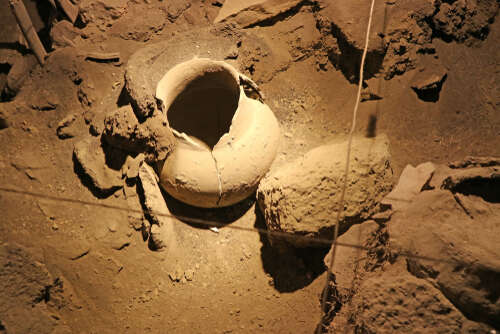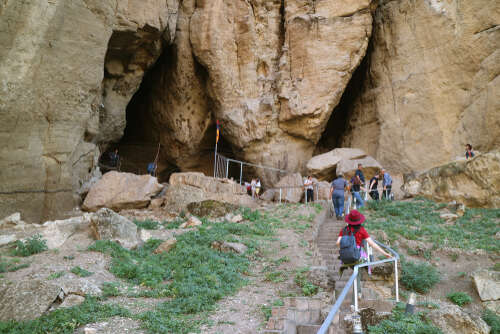
As new research emerges challenging established ideas on the evolution of Vitis vinifera, Stuart Walton ponders the origins of wine, and the branch of vinous history that can be traced back to Armenia’s Areni-1 cave.
A research paper published in the journal Science in March 2023 has established that, contrary to what was previously thought, the wine grape Vitis vinifera evolved not from one geographical centre in the Caucasus, but separately from sites in the Near East as well. These latter migrated westwards, cross-pollinating with wild grape species, eventually to become the repertoire of internationally known varieties from which most of the world’s wine is made. In the Caucasus—modern-day Armenia, Azerbaijan, and Georgia—an entirely distinct development was triggered, leading to the regionally specific cultivars that still distinguish the increasingly commercially significant wines of those regions.
What these suggestive findings may eventually promote is a comparative deepening of our understanding of how vinification cultures developed in the two viticultural regions. For decades, the oldest wine press ever discovered was the one unearthed at a site on the West Bank of the Jordan in 1963, which dates from around 1650BC, and would have processed grapes of the Near Eastern genotype. During a series of excavations in Armenia between 2007 and 2010, however, at a site in the Lesser Caucasus Mountains near the country’s border with Iran to the south, a considerably more ancient winery establishment was uncovered.
There is no doubt about the findings. Virtually every item of equipment familiar to the modern winemaker was discovered: a grape press, fermentation vessels, storage jars, and drinking vessels marked with the evidence of wine. Residues of crushed red vinifera grapes in a remarkable state of preservation are only the half of it. The press is mounted above a deep collecting vat with a capacity of around 65 litres, clearly designed for foot-treading of the fruit. The entire complex is dated to around 4100-4000BC, and is of a degree of sophistication to suggest that the technology it contains had already been developed at a much earlier date than that.
The expedition’s joint leader, the late Professor Gregory Areshian of the Cotsen Institute of Archaeology at UCLA, suggested that the wine produced in the Areni-1 cave (named after the nearby village) was not for everyday consumption among what seems to have been a dynamic trading community. It would appear instead to have a more ceremonial significance, and was probably produced for use in rituals honouring the recently departed, as is suggested by the proximity in the cave of a row of burial sites. The whole complex appears to have been abandoned in antiquity following the collapse of its roof, its extraordinary preservation being largely due to deposits of sheep dung that inhibited fungal erosion of the remains.
The meaning of Areni-1
Not the least important conclusion to be draw from the Areni-1 cave is that the grapes being used in the wine vinified there were of the vinifera strain, as opposed to the wild Vitis silvestris species, a a markedly inferior material for wine production. In other words, the grapevine had already been domesticated in this region, perhaps for many centuries previously, but the varieties that developed there remained confined to a relatively modest geographical catchment area that extended to both sides of the Caucasus range and into the Pannonian (or Carpathian) Basin. They might have made it about as far west as modern-day Hungary.

While the rest of the known world measured out its viticultural history in Chardonnay and Cabernet Sauvignon, what has become known as the CG2 (Cultivated Grape 2) paleobotanic area bequeathed varieties such as Georgian Saperavi and Rkatsiteli to local preference. King of the Armenian wine industry is a varietal known as Areni, after the precise area in the Vayots Dzor province in which the ancient cave complex is located. There are vines here of over a century old that are still fruiting. Although indigenous to the district, Areni is now grown throughout Armenia’s vineyard regions on a mixture of calcareous and volcanic soils for making rich, peppery reds and delicate, cherry-scented rosés. The reds respond well to ageing in indigenous oak, turning sweet and plummy in the maturation. We can no more say that they offer a taste of the ceremonial wine of Areni-1 than we can say that Cabernet from ungrafted pre-phylloxera rootstock tastes like it would have done in the 19th century, but there is undoubtedly a historical lineage connecting it, however evanescently, to the far-distant past.
Intriguingly, the other notable find in Areni-1 was a perfectly preserved leather shoe, the oldest known item of leather footwear yet found. We can surely allow ourselves the imaginative licence to see its wearer kicking it off along with its lost partner, prior to clambering into the grape press to honour the ancestors.






